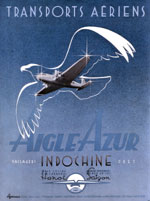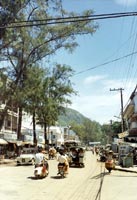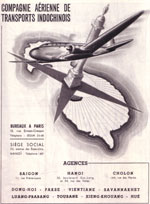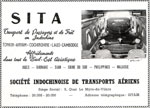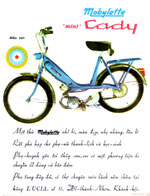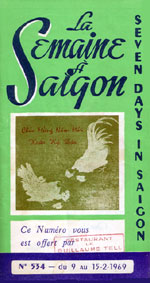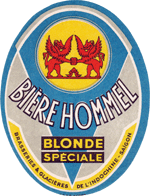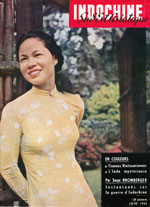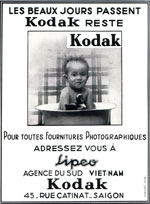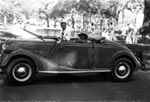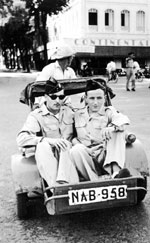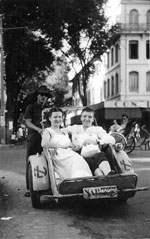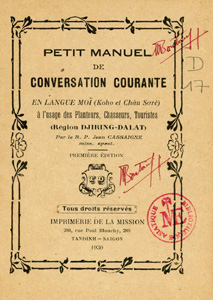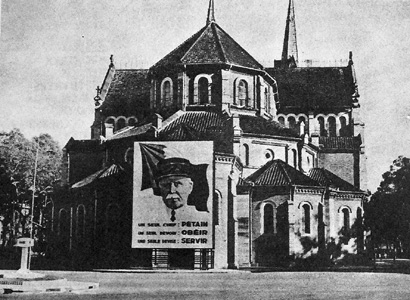

Monsignor Jean Cassaigne (1895-1973)
The last French bishop of Saigon
─Éß╗®c cha Jean Cassaigne
Jean Cassaigne was born on January 30, 1895 in Grenade-sur-l'Adour (Landes) at 25 rue des Capucins.
He studied with the Brothers of the Christian Schools who had taken refuge in Spain after their expulsion in 1905 by the anti-clerical laws of the Third Republic in San Sebastian. In 1911 he was expelled from his San Bernardo college because of his turbulence (He excelled in organized rowdiness), but in 1913 he entered the apostolic college of Saint-L├┤ (Manche) dedicated to preparing late vocations.
Jean Cassaigne
Croix de Guerre (Military Cross)
and Mentioned at the Order of the 6th Dragoons

In 1914 Jean Cassaigne, at the age of nineteen, was enlisted as a volunteer for the First World War. Shortly before the 1916 offensive on the Somme, Jean Cassaigne became a cyclist on the staff of the 6th Dragons. He liaises between the staff barracks in the rear and the most advanced command posts. Throughout 1917, Jean Cassaigne pedaled on the rotten roads of the front, to the northeast of Compiègne, then a little further east, near Coucy-le-Ch├óteau. The lines are barely a hundred kilometers from Paris!
At the beginning of September 1918, he waded for three days in a flooded trench, stricken with fever, he was evacuated to the Provins Hospital. Following a broncho-pneumonia he was evacuated to Tarbes, it is in this city that he will learn the cessation of hostilities with the armistice of November 11, 1918.
(© Source Louis & Madeleine Raillon in their book: "Jean Cassaigne, leprosy and God" published in 1993 by ├ēditions Saint-Paul)
Demobilized in 1919, he returned to Saint-L├┤ then returned to the seminary on rue du Bac in Paris in 1920. He was ordained a priest there by Monseigneur de Gu├®briant, superior of the Foreign Missions on December 19, 1925. He was destined for the mission of Indochine and embarked in Marseille on April 6, 1926 aboard the ship "D'Artagnan".

Plan of Dijing
PProvince of Haut Donnai (decree of October 31, 1920)

Monsignor Cassaigne in the midst of the Moïs who came
in Saigon for his coronation

Father Cassaigne was received by Bishop Dumortier, Bishop of Saigon, he was sent to Caimon, near Mytho, to study Vietnamese with an experienced missionary. This language surprises Westerners with its accent and its monotony.
Father Cassaigne learns very quickly, but he is not satisfied with a catechumenal parish, because a missionary must bring the Gospel to those who have not yet received it.
Only a few months later, his bishop sent him to establish a mission in the Highlands, 170 kilometers northeast of Saigon. This mountainous region separates Cochinchina from Cambodia.
He arrived in his new assignment in January 1927. The center of the parish was a small hamlet called Djiring (Di-Linh today).
Less than half a century old, the maps leave the area blank with the mention: ŌĆ£wild landsŌĆØ. There lived the "Muslims" or "semi-openers".
They are very diverse ethnic groups, in reality animists for a long time on these high plateaus. Around Di-Linh live the Sré and the Maa. They are isolated, benefit little from technical progress and their way of life is very simple. The men and women of these tribes are by nature very gentle and very hospitable. No foreigner has yet learned their language, Koho (K'Ho).

Father Cassaigne
What a mission for a missionary!
"Foreseeable difficulties do not frighten me", he writes, because "suffering does not prevent one from being happy".
Next to his new home, he built a chapel for the first devotees of Di Linh, locally employed "Annamates". This is where he will celebrate Mass:
"Lord, you are in your house"
The missionary, who gave him the gun, assured him that he would use it: "even if it was only to kill tigers".
On the opposite hill, the priest saw the thatched-roof houses of the local people. These huts, with two pointed straight roofs, are built on poles.
How to reach these mountaineers whose approach is not easy?
Candy for the kids, of course.
Tobacco for adults, men and women, because in this place everyone smokes from a young age.
In a very short time, Father Cassaigne was very popular with everyone, so much so that the master of the village invited him to drink, in a common jar, the rice alcohol that the inhabitants appreciated.
But it is the children who are the first to teach the Koho (Moi) language to the new visitor. Little by little, the missionary progresses. He ended up publishing a script for that language and publishing a concise dictionary. But how long does it take to really be able to announce the Gospel in this language?
Father Cassaigne begins to visit the hamlets around Di Linh. Thanks to the medicine kit, he provides first aid to many patients and bandages them. He gains everyone's trust. Leprosy patients come to his home for regular care and food. But one day he notices that a patient hasn't come back for a fortnight.
The missionary will find her, like the Good Shepherd in search of the lost sheep, as Jesus said. He discovered her dying in a separate log cabin in an abandoned village, lying in the dark, just above the ground.
"Praise the Lord! I found the woman". She chose to die here. His eyes turn to the priest: "Monsignor, please stay away. You can't do anything for me!".
The missionary sits down and begins to talk to him about God:
"The Lord is our Father and He wants good for us. Do not be afraid".
It was the first time he spoke of God in the Koho language..
God will welcome you to paradise, where you will be happy forever. God loves the leper and all that he has created.
"What should I do, Father?" asks the dying woman.
"Give the Lord your sufferings and forgive those who have rejected you".
The kindness of the missionary convinced the woman and she agreed to be baptized. He ran to get water, because there was no water in the cabin. Then he gives her a drink, wipes her face and finally baptizes her with the holy name of "Mary".
She repeats after him the words of the "Our Father", which he translates into the Koho language. Mary is exhausted. The priest recites the rosary while waiting for her to fall asleep. The next day she died.
"I will remember you in heaven" the woman said before she died. Father Cassaigne digs himself a grave.

The Djiring Chapel
The Village of Joy
Shortly after, the Missionary proposes to the lepers to build a village which will become their village. No more lepers will be left out: everyone will be cared for, housed, educated and, if ready, baptized. Unable to heal seriously ill bodies, Father Cassaigne soothes hearts and heals souls. Sure enough, soon after, a village of traditional houses was built, built by the lepers themselves, helped by healthy people from the original villages..
"To build is not to die", says the priest. He admires the energy of disabled patients. Leprosy patients know well that they are loved. They find there the strength to live and work.
The village is like a house, where the priest gathers his children. Because for the missionary, the lepers are like his children. And He always called them that. He takes care of lepers like a father who takes care of his children.
He personally took care of them by thinking about their wounds by giving them medicine for years.
This village is growing rapidly. A village chief is appointed. The less disabled patients grow fruit and vegetable crops around their huts..
The first celebration was the inauguration of the new village in April 1929. It began with an outdoor mass. The mass has just ended when a loud gong sounds, probably due to an impatient leper. Everyone bursts out laughing. Some of the men are wearing pants given to them by Father Cassaigne. Everyone smokes freely, even those who have lost their fingers, and everyone goes to the wine jars, drinking through bamboo straws. Food is abundant: vegetable soup, grilled fish, tree worms, dried boar meat. Buffalo meat is very popular. There is no limit to rice, but people add chili to it. Everyone is extremely satisfied. Full of laughter. These parties remain memorable.
Thanks to Father Cassaigne, lepers become human again...
Father Cassaigne also organizes film screenings. Charlie Chaplin is very successful; everyone understood the silent films of the time, even those who only spoke Koho!
Lepers often burst out laughing. "Smiling is also a healing ingredient", explains Father Cassaigne with humor.
It is the Village of Joy.
Shortly after, the inhabitants of the village build a chapel: many lepers are converted..
Can a village be a village of joy if there is not a chapel in which the priest prays with his children? There can be no real and lasting joy without prayer.
The witnesses who attend the prayers of the lepers are moved to hear the solemn and grave voice of the ethnic group, seeing how different it is from the prayer voice of the Vietnamese people.

The Djiring delegation
the national road between Saigon and Phan-Thiêt

The leper village of Djiring
The Colonial Annals ~ June 7, 1931
by Marcel Ner from the newspaper "The Economic Awakening of Indochina
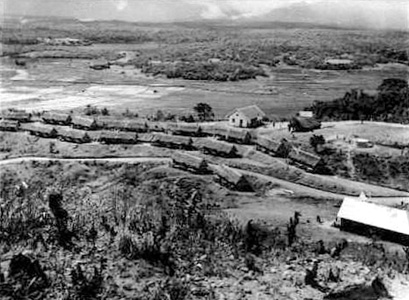
I had already seen another group of lepers, gathered near Djiring by a Father who depends not on the Bahnar mission but on that of Cochinchina. Came to Indochina a few years ago and recently settled in Djiring, whose mild but unhealthy climate recalls that of Kontum, this Father, despite the fever which struck him hard, was able, in a short time, to learn, besides Annamese, the language of a region of which he was the first to attempt evangelization. He was thus able to publish two vocabularies, French-Annamite-koho, of great practical and scientific interest.
Emulator of the Fathers of Kontum, he also began, with the help of the Administration, which had huts built, a road laid out, gives a daily allowance of 20 cents per patient and provides medicines, the creation of a village of lepers.
No constraint is exerted on the patients, who are however already about sixty in number. This freedom, as well as the relative well-being they enjoy, are the necessary conditions for their arrival. This special village, whose inhabitants live in small groups in tiny huts on stilts, is organized in the manner of the Moï villages, has a chief responsible for the good running of the village and who, under the direction of the missionary, judges the disputes.
The Father distributes food every Saturday: rice, dried fish, salt, tobacco, game, etc. Four or five times a year, at the time of the big Moi festivals: sowing, harvest, etc., the lepers also have their feast, receive a little alcohol, cakes, cigarettes, pipes, necklaces, etc. ...
As in Kontum, they go to the nearby forest to look for the wood and also the culinary resources that it provides to the Moï.
They are provided with tools for cultivation and the most able-bodied have a small garden around their house..
Those most affected are supplied with water and wood by the most able-bodied, who receive a small payment for this purpose..
There again, moreover, harmony seems to reign between these men also struck by a terrible disease and who know that their fate could have been much more terrible..
In the center of the village is the infirmary where, three times a week, the missionary comes to do the dressings and distribute the necessary medicines. The invalids were cared for in their straw huts and received, in addition, a larger ration of sweets which the missionary could obtain.
The usual medicines are potash permanganate baths, after which the wounds are sprinkled with cinchona powder or another product and dressed; tincture of iodine, Dakin's liquid, oxyanide of mercury.
Chaulmoogra oil, in liquid form or in pills, has also been tried but does not give any results, the lepers who come to the village are already too affected. Its high price and the minimal resources available do not allow it to be used routinely. The other illnesses from which these poor bodies suffer are cured by common remedies, which the Moi appreciate when they have a pleasant taste, such as the paregoric elixir and, above all, castor oil, which is their treat. .

Small manual of everyday conversation in the Moï language
(Koyo-Châu Sorê)
by Reverend Father Jean Cassaigne
Photo on the left: Father Cassaigne with two children from the village of lepers
Photo on the right: Small manual of everyday conversation in the Moï language (Koyo-Châu Sorê) by Reverand Jean Cassaigne: published in 1930. Printing office of the Mission 289 rue Paul Blanchy Saigon.

Nuns for lepers
"LŌĆÖÉveil économique de lŌĆÖIndochine", July 10, 1932
The Saigon press welcomes the upcoming arrival in Indochina of Franciscan Missionaries of Mary who come to devote themselves to lepers. Their first establishment will be in Annam at the leper colony founded at Qui-Ho├Ā, province of Quinhon, by the late Father Maheu and Doctor Le Moine.
Some will perhaps also take care of the new leprosarium which a missionary is in the process of founding near Djiring, on the passage of the road from Saigon to Dalat..
This last leprosarium is intended for the Moïs, the idea of Father Maheu has taken root and Father Cassaigne, parish priest of Djiring, has already been able to accommodate more than seventy-five unfortunate people who will remain, despite all the efforts of the Father, far from the doctrine Christian. It is therefore clearly a work of pure charity.
Moreover, the Administration insisted on participating in the maintenance of these lepers and subsidizes them daily at the rate of 0$20 per head.
Sick, Father Cassaigne had to return to France to take some rest, but another Father replaced him. Indeed, although he too was suffering, Father Sion agreed to continue the work of devotion and abnegation.

Preparation of a parade in Djiring
© photo by Raymond Chagneau

The rear of the cathedral of Notre-Dame of Saigon in 1941
In 1941 The rear of the cathedral of Notre-Dame of Saigon with Marshal Petain's propaganda poster.
After the death of the Bishop of Saigon Isidore Dumortier in 1940, on June 24, 1941, Saint John's Day, his feast day Jean Cassaigne, was consecrated bishop in Notre-Dame Cathedral.
The first difficulties will arise on July 29, 1941 when the Japanese troops settle in Saigon. Monsignor Cassaigne must turn away Japanese officers who have come to visit the bishopric, with a view to requisitioning it. Indignant, he meets the Governor General, Admiral Decoux, who approves of it.
On May 6, 1944, Saigon was bombed by American aircraft. Monsignor Cassaigne rides his bicycle, as during the First World War in the battles of the Somme and the Oise, a Red Cross armband on his sleeve. The Bishop quickly arrives on the scene, near the wounded, the dying too. The toll will be heavy: there were 250 killed and 360 injured.
On February 7, 1945, American planes bombed downtown Saigon. The Grall hospital is affected, there are more than 200 bomb craters! In the evening, Monsignor Cassaigne walks through his cathedral, in the middle of the rubble, the roof has been blown off, the stained glass windows broken.
On March 9, 1945, the Japanese attacked the French barracks.
The commander-in-chief of the Japanese army has just declared martial law:
"Admiral Decoux violated the 1941 agreement on Common Defense, by refusing to place French forces under the Japanese commander. Admiral Decoux was arrested along with all senior French officials. Japanese forces suppressed the resistance of the French troops, now disarmed and prisoners. Any individual who is caught in arms will be immediately shot."
At the end of the day, two Japanese bring an order to Monsignor Cassaigne: tomorrow, Sunday, the cathedral must remain closed. Offices are prohibited..
The Kempetai, (often referred to as the Japanese Gestapo by resistance fighters), locked up many French soldiers in cages.
On the evening of March 11, a Japanese delegation presented itself at the bishopric. Escorted by Captain Konishi and an interpreter, Mr. Odakha, Colonel Amano asks Monsignor Cassaigne, with Japanese solemnity,"to be the intermediary between the Japanese Army and the French population."
No! he replied very angrily. And no, it's no!
The Japanese seize French Indochina while the outcome of the Pacific War in favor of the Allies is no longer in any doubt. After this coup, punctuated by numerous massacres, thousands of French people, civilians or soldiers, were deported to camps, imprisoned in prisons or placed under house arrest.
These men and women experience appalling conditions of detention in the dungeons and prisons that dot the peninsula from northern Tonkin to southern Cochinchina. Under the supervision of the Kempeitai, they participate in exhausting work, suffer from hunger and thirst, suffer beatings and torture when they are not crammed into fetid tiger cages from which they never see the light of day.
It is estimated that more than 3000 Europeans died during this period. The survivors, including the author's grandparents, have always been convinced that they owe their lives only to the nuclear explosions of Hiroshima and Nagasaki.
These French people from the end of the world remain forgotten, however, crushed between the liberation of the metropolis and the Indochina war which is announced, when they are not suspected of complacency towards the Vichy regime. Almost seventy years later, it is time for this tragedy to take its rightful place in the history of the Second World War.
At the background the cathedral of Saigon duringg the Second World War.

The daily life of the Saigon people during the Second World War

"Le Populaire d'Indochine" of Wednesday, June 9, 1948
Assassination attempt against Monsignor Cassaigne

Monsignor Cassaigne was to be killed
Two terrorists were arrested.

We learn that Monsignor Cassaigne, Apostolic Vicar of Saigon, would have escaped an attack on the night of June 7 to 8.
As some soldiers returned late in the evening to their quarters, and walked along the rue Richaud, they saw two shadows, which crossed the gate of the bishopric.
These two forms dressed in black escaped the glance, and it was with the axial lighting that they could be guessed.
This attack against the prelate would have continued the long series of the clergy of Saigon-Cholon fallen in the accomplishment of their mission.
Perhaps one would find in the fact that the head of the diocese recently sent General Nguyß╗ģn V─ān Xu├ón (*) a letter approving the constitution of the central government which privileged the reason for the assassination.
We are happy that the composure of a few men was able to avoid any unfortunate end.
Monsignor Cassaigne finds here the expression of our sincere sympathy and our joy to see him safe and sound.
((*) Nguyß╗ģn V─ān Xu├ón was appointed brigadier general in 1947, thus becoming the first Vietnamese general in the French army, head of the government of Cochinchina from 1947 to 1948, then of the Provisional Central Government of Vietnam from 1948 to 1949.

On December 19, 1954 Monsignor Cassaigne discovered the first signs of leprosy on his body. This diagnosis was confirmed on February 24, 1955 by the Pasteur Institute in Saigon.
On March 5, 1955, Monsignor Cassaigne wrote to the Superior of the Foreign Missions of Paris:
"I therefore ask your Excellency, in the event that my illness becomes clearly visible, to allow me to submit my resignation to the Holy See and to retire to the leprosarium of Djiring, near my children whom I have the most beloved and whom, in his goodness, the divine Master allows me to resemble."
After several stays at the Grall Hospital he asks:
"If you do me the favor of retiring to Djiring 230 kilometers from Saigon, I could still serve, and treat, without inconveniencing and without being at the expense of anyone."

from to Dalat

Monsignor Jean Cassaigne in the midst of the Moïs in Djiring
"My return among the Montagnards was greeted with explosions of joy, a joy that was well shared, because once again becoming a fully missionary, I could never thank the Good Master enough for the great grace he granted me and the Holy Father of the favor I had asked him to retire to the very place where I had begun my apostolate. I am sure that you understand me and share my joy because, in leaving Saigon, I regret nothing, I have lost nothing, on the contrary, I won everything. I did my duty there for fourteen and a half years and I am sometimes surprised to have been able to hold out for so long" he wrote in 1955 to his cousins in Urgons (Landes)."

Timetable
- 6 am, he is in the chapel, preparing the altar, ringing the bell. Immediately, the faithful of the daily mass, a good dozen lepers who approach the Holy Table every day. "On Sundays, there are more of them, between seventy and seventy-five, a small parish but how fervent".
- 8:30 a.m. After his breakfast, he goes from hut to hut, worrying about health, problems, needs. Visit more or less, depending on the case.
- 10:30 a.m. Reading of the breviary in the chapel, while waiting for the children to arrive for catechism.
- 12:00 p.m. Return to Kala, as a guest of Father Daricau. He has changed, but he hasn't given up on the lunch break. He admits that he does not like to eat alone. The Sisters prepare his ration of rice and meat or fish for him, which he takes away in his 2CV Citroën. - But more than food, he has a taste for these exchanges, these friendly conversations with his colleague, which, apart from the leposery, constitute his entire social life.
- 2:30 p.m. After the siesta, the afternoon is shared between visiting the seriously ill in the infirmary and personal work. Then with his notepad and his pencil, he stops in front of each hut and takes care of the shopping for the lepers in Djiring (purchases of cigarettes, household items, sweets and others) which he distributes the next morning. "Be attracted by what is humble!". He makes himself more and more the servant of the poor people.
- 6 p.m., he enters the chapel for the prayer of the lepers, leaves the last, after his meditation. When the weather and his pain allow it, he walks alone on the paths of the leprosarium, reciting his rosary, until nightfall.
Monsignor Cassaigne at the end of his life accompanied by lepers in the village

Visit of General Nguyß╗ģn V─ān Hiß║┐u
at the bedside of Monsignor Cassaigne
Thus, on April 12, 1972, at half past nine, enter the room of Monsignor Cassaigne, General Nguyß╗ģn V─ān Hiß║┐u, assistant to the Vice-Presidency of the Republic of South Vietnam, Lieutenant-Colonel, Head of the Province of Lam-Dong, as well as Father Dozance and Father Quang, parish priest of Di-Linh. Mr. Nguyen Thach Van, Secretary of State leans over the patient's bed, proceeds to the presentation of the decoration.
Very moved, Monsignor Cassaigne thanked each of the people present. He does not ask for these decorations but they are generally accompanied by donations which help to finance the leper colony.
"I thank the Vice-President, with the heart of a missionary. In gratitude, I can only pray, pray for Vietnam, which I do every day; for Vietnam where I have lived for 48 years and I love more every day. Vietnam is my homeland. God wanted it that way. My dream will soon come true: I held on, I suffered here, I am going to die and want to be buried with my children. , in the mountain country."
©Source Louis & Madeleine Raillon in their book: "Jean Cassaigne, leprosy and God" published in 1993 by ├ēditions Saint-Paul.
General Nguyß╗ģn V─ān Hiß║┐u at the bedside of Monsignor Cassaigne

Photo taken in the 1970ŌĆÖs of the interior of Djiring Chapel

Caritas & Amor
Funeral of Monsignor Cassaigne in Djiring
The funeral of Monsignor Jean Cassaigne took place on November 5, 1973. More than three people attended this ceremony, with the representatives of President Nguyß╗ģn V─ān Thiß╗ću, the Vice-President, the civil and military authorities, the French Ambassador Jean-Marie Merillon.
The funeral mass is concelebrated, under the presidency of Monsignor Paul Nguyên Van Binh, Archbishop of Saigon by eleven bishops and seventy priests.

Tomb of Monsignor Jean Cassaigne at the leprosarium of Di Linh (Djiring)
Mß╗Ö Gi├Īm mß╗źc Jean Cassaigne tß║Īi trß║Īi phong ß╗¤ Di Linh (Djiring)
Photo on the left taken in 1974: A large white cross has been erected, at the foot of which are engraved the words Jean Cassaigne - Carita et Amor - 1895-1973
P hoto on the right taken today: With inset Monsignor Jean Cassaigne.

Booklet published in October 2019
by the Diocese of Saigon
The extraordinary month of the mission with Monsignor Jean Cassaigne

Thanks
A big thank you to Gilles Saint-Martin of the association "Les Amis de Mgr Cassaigne" of Grenade sur l'Adour who helped us in this page. This association preserves the memory of Jean Cassaigne's action and makes his message alive even today.
It will publish in 2022 a photo book which will be entitled "Jean Cassaigne (1895-1973), the bishop of the lepers Illustrated chronicles to the Landes to Indochina" which will be published during the year 2022.
Many photos will be unpublished and about forty will be devoted to the period of Bishop of Saigon.
The Di-Linh leprosarium is still active. The Daughters of Charity are always engaged there in the service of the poorest.
In Saint-Pierre-du-Mont, in the Landes, a school group bears the name of Jean Cassaigne..
A Jean Cassaigne Foundation has been created under the aegis of the Raoul Follereau Foundation to support the actions undertaken in its name.
This Prize rewards each year a French solidarity organization for its action in favor of vulnerable populations in a country of the South..
The Catholic authorities of Vietnam are preparing a request for beatification in collaboration with the Foreign Missions of Paris.
Email Contact for the Association of Friends of Monsignor Cassaigne


The 2022 Jean Cassaigne Prize
 |
Prix Jean Cassaigne des lycéens pour la solidarité internationale 3ème édition 2021/2022 Source (Prix Jean Cassaigne) |
|---|

Sold out
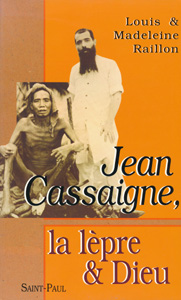 |
Louis & Madeleine Raillon La lèpre & Dieu paru en janvier 1993 Édition Saint-Paul Paris Fribourg |
|---|

Available at the bookseller's
 |
Frédéric Sudupé Jean Cassaigne au service des oubliés Frédéric Sudupé voit en Jean Cassaigne, comme il existe des aventuriers de l'esprit un aventurier du cœur. Un passeur de vérité Édition Passiflor |
|---|
 |
Louis & Madeleine Raillon La lèpre & Dieu paru en mai 1997 Édition Saint-Paul |
|---|
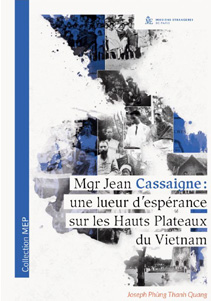 |
Père Joseph Phùng Thanh Quang Mgr Jean Cassaigne Une lueur d'espèrance sur les Hauts Plateaux du Vietnam paru en 2022 Édition : Missions étrangères de Paris |
|---|---|
 |
Jean Cassaigne 1895-1973 L'évèque des Lépreux Chroniques illustrées des Landes à l'Indochine un livre de photos dont beaucoup sont inédites. Édition Association : "les amis de Monseigneur Cassaigne" |
















